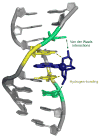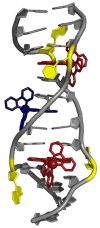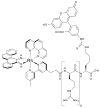Metallo-intercalators and metallo-insertors
- PMID: 17989802
- PMCID: PMC2790054
- DOI: 10.1039/b710949k
Metallo-intercalators and metallo-insertors
Abstract
Since the elucidation of the structure of double helical DNA, the construction of small molecules that recognize and react at specific DNA sites has been an area of considerable interest. In particular, the study of transition metal complexes that bind DNA with specificity has been a burgeoning field. This growth has been due in large part to the useful properties of metal complexes, which possess a wide array of photophysical attributes and allow for the modular assembly of an ensemble of recognition elements. Here we review recent experiments in our laboratory aimed at the design and study of octahedral metal complexes that bind DNA non-covalently and target reactions to specific sites. Emphasis is placed both on the variety of methods employed to confer site-specificity and upon the many applications for these complexes. Particular attention is given to the family of complexes recently designed that target single base mismatches in duplex DNA through metallo-insertion.
Figures















References
-
- Demeunynck MC, Bailly WD. Small Molecule DNA and RNA Binders: From Synthesis to Nucleic Acid Complexes. Weinheim: Wiley-VCH; 2002.
-
- Lippard SJ, Berg JM. Principles of Bioinorganic Chemistry. Mill Valley: University Science Books; 1994.
- Bertini I, Gray HB, Lippard SJ. Bioinorganic Chemistry. Mill Valley: University Science Books; 1994.
-
- Erkilla KE, Odom DT, Barton JK. Chem Rev. 1999;99:2777. - PubMed
-
- Jamieson ER, Lippard SJ. Chem Rev. 1999;99:2467. - PubMed
-
- Watson JD, Crick FH. Nature. 1953;171:737. - PubMed
- Saegner W. Principles of Nucleic Acid Structure. New York: Springer-Verlag; 1984.
Publication types
MeSH terms
Substances
Grants and funding
LinkOut - more resources
Full Text Sources
Other Literature Sources

